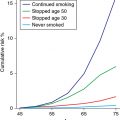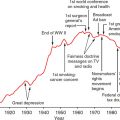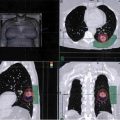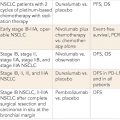A 50-year-old Hispanic male is treated for metastatic adenocarcinoma of the lung. He complains about cough, shortness of air, and severe back pain. He does not tolerate narcotics well and appears very depressed. Learning Objectives: 1. What are the different types of palliative care available to cancer patients? 2. How are common symptoms in lung cancer patients evaluated and managed? 2. How is pain in cancer patients managed? Supportive care in cancer is the prevention and management of the symptoms and side effects of cancer and its treatment across the cancer continuum from diagnosis to the end of life. There is mounting evidence in oncology that early and effective supportive care is linked to better quality of life and survival.1,2 The delivery of palliative care can be categorized as primary, secondary, and tertiary. • Primary palliative care is the provision of basic symptom management and psychosocial care by -ology teams and primary care clinicians. • Secondary palliative care refers to consultation services provided by interdisciplinary specialist palliative care teams. • Tertiary palliative care denotes the situation when a palliative care team becomes the primary coordinating team. Patients with advanced cancer have multiple symptoms and require systematic assessment. Patient descriptions of physical symptoms and their severity are the primary data for symptom assessment. Formal multiple-symptom assessment tools provide a good overview of symptoms in individual patients. A number of validated multiple-symptom assessment tools are in wide usage in palliative care settings, including • The revised Edmonton Symptom Assessment Scale3 (Figure 19-1) Figure 19-1. Edmonton Symptom Assessment System: revised. (Reproduced with permission from Watanabe SM, Nekolaichuk C, Beaumont C, et al. A multicenter study comparing two numerical versions of the Edmonton Symptom Assessment System in palliative care patients. J Pain Symptom Manage. 2011;41:456. © 2011 U.S. Cancer Pain Relief Committee. Published by Elsevier Inc. All rights reserved.) • Memorial Symptom Assessment Scale–Short (MSAS) Form • M. D. Anderson Brief Symptom Inventory • Rotterdam Symptom Checklist • Symptom Distress Scale Multiple-symptom assessment tools are highly effective in recognizing unreported symptoms when combined with further patient interviewing to delineate the details of positive responses. When a specific tool has been chosen, it should be used consistently to ensure reliability in the clinical setting. This chapter includes a discussion about assessing and treating highly prevalent symptoms in a lung cancer patient. Cancer-related anorexia/cachexia syndrome (CACS) is a debilitating wasting syndrome that affects many patients who are undergoing treatment for a malignancy. Cachexia is a complex metabolic syndrome associated with underlying illness and characterized by loss of muscle with or without loss of fat mass. The prominent clinical feature of cachexia is weight loss in adults (corrected for fluid retention) or growth failure in children (excluding endocrine disorders). Anorexia, inflammation, insulin resistance, and increased muscle protein breakdown are frequently associated with cachexia. Unlike wasting, cachexia is not reversible solely by caloric supplementation. Its etiology is multifactorial: 1. Physiological burden of the malignancy, which serves to increase basal metabolic energy expenditure 2. Hormonal disruptions 2. Body composition changes 3. Poor intake secondary to anorexia The effects of CACS are far reaching, with patients reporting increased fatigue, weakness, and poorer qualities of life. Patients also exhibit less favorable responses to chemotherapy agents and suffer shorter survival times. The radical change in physical appearance of the patient and the inability to continue to enjoy family mealtimes are sources of significant psychosocial distress. Early identification of cachexia is important, as prompt intervention can affect clinical outcomes as well as quality of life. Therefore, it is recommended that all cancer patients should ideally undergo nutritional screening at the time of cancer diagnosis to identify patients with and those at risk for malnutrition or cachexia. More recently, an international group of researchers developed a definition and classification system for cachexia in cancer4: The following are the criteria for cancer cachexia: • weight loss greater than 5%, or • weight loss greater than 2% in individuals already showing depletion according to current body weight and height body mass index (BMI) 20 kg/m2 or less, or • skeletal muscle mass (sarcopenia) and weight loss greater than 2%. These experts considered three stages: precachexia, cachexia, and refractory cachexia. Careful history must be obtained with a focus on nutritional issues, including risk factors that compromise the ability to obtain or take in nutrition, anorexia or reduced food intake, functional and psychosocial impairment. Also evaluate for major contributors to anorexia, such as nausea and vomiting, constipation, taste alterations, xerostomia, mucositis, pain, dyspnea, and depression. The following interventions are recommended: Nutritional Counseling: Strategies should be employed that help to increase nutritional intake by focusing on multiple small, caloric-dense, meals throughout the day. • Alleviate anxiety and improve adherence by helping the patient to identify foods that he or she finds pleasurable and try to incorporate these foods into all mealtimes. Although there are no extensive data on the efficacy of nutritional counseling, most cancer patients will agree that they find it helpful; thus, it is often a good place to begin. Pharmacological Interventions: Palliating the anorexia aspect of CACS with appetite stimulation has long been considered an important area of focus, with corticosteroids and progesterone analogues successfully used in this capacity for many years. Corticosteroids: Dexamethasone, prednisolone, and methylprednisolone have all been shown to be effective. • Long-term side effects: Adrenal suppression, myopathy, decreased bone mineral density, peptic ulcer disease, as well as many others, are common side effects and should be considered on a per patient basis. • Suggested dosing regimens: Dexamethasone up to 4 mg/day Progesterone analogues: Megestrol acetate and medroxyprogesterone acetate are the most commonly used. • Long-term side effects: Progesterone analogues have been shown to increase the risk of prothrombotic events. Additionally, due to mild glucocorticoid-like effects, stress dose steroids may be required in trauma, surgical, or septic patients. • Suggested dosing regimens: Megestrol acetate 160-800 mg/day (liquid formulation may be tolerated better by patients). • Note: Considered to be superior to glucocorticoids due to a quick onset of action, a longer lasting effect on appetite stimulation, and a less severe side-effect profile. Mirtazapine: This tetracyclic antidepressant induces weight gain and increases food intake. The dose is 15-30 mg by mouth daily at bedtime. Others: Myriad other agents, including androgens, cannabinoids, ghrelin analogues, tumor necrosis factor alpha inhibitors, as well as many others, have been hypothesized to help patients with CACS. To date, however, further information is currently required from randomized trials—many of which are still ongoing—before any recommendations can be made. Cancer-related fatigue (CRF) is one of the most common symptoms experienced by patients with malignancies. Eight of 10 cancer patients undergoing cytotoxic chemotherapy, biotherapy, and/or radiation therapy endorse fatigue. Despite its high prevalence, CRF is often underdiagnosed and undertreated. Cancer-related fatigue is a distressing, persistent, subjective sense of physical, emotional, and/or cognitive tiredness or exhaustion related to cancer and/or cancer treatment that is not proportional to recent activity and interferes with usual functioning. Its etiology is multifactorial: 1. Increased levels of systemic inflammation 2. Skeletal muscle wasting 2. Metabolic dysregulation 2. Psychological distress 2. Medication side effects 3. Circadian rhythm desynchronization Unlike everyday fatigue, which is temporary and able to be relieved by rest, CRF is chronic and unrelenting. For these reasons, it is consistently reported to be one of the most distressing symptoms to affect cancer patients. CRF may have ongoing effects for years after remission is achieved or treatment is discontinued. The implications of this are far reaching, with patients suffering from a reduced quality of life at home as well as, at times, an inability to maintain a job. When should you screen for fatigue?5 • Initial visit • Conclusion of primary therapy • Yearly during follow-up survivor care appointments • During each visit in patients with advance disease The visual analog scale (VAS) can be employed by asking a patient to rate his or her fatigue severity on a scale of 0-10. Mild, moderate, and severe fatigue are represented by scores of 1-3, 4-6, and 7-10, respectively. A score of 4 or above requires a focused evaluation. The Brief Fatigue Inventory (BFI) is an alternate option for quick screening (https://www.mdanderson.org/research/departments-labs-institutes/departments-divisions/symptom-research/symptom-assessment-tools/brief-fatigue-inventory.html). A common differential for fatigue is • Disease status: consider recurrence or progression • Assess for anemia, pain, sleep disturbance, emotional distress: depression or anxiety, medication side effect (drug interaction, over-the-counter [OTC] medications), substance abuse • Nutritional deficiencies: vitamin status, weight/calorie intake change, electrolyte imbalance • Endocrine dysfunction: hypothyroidism, hypogonadism, adrenal insufficiency • Cardiac dysfunction The following interventions are recommended5: Lifestyle modifications and non-pharmacological interventions6: • Patient education and reassurance: It is important to inform patients that increased levels of fatigue do not necessarily equate to disease progression. • Establishment of adequate support systems: Delegating daily tasks to friends and family members can allow for patients to conserve what little disposable energy they may have. • Counseling on good sleep hygiene: Although CRF cannot, by definition, be relieved by rest, insomnia can worsen symptoms. • Healthy distractions: During waking hours, activities that give meaning and fulfillment to the patient should be prioritized. This has been shown to help decrease fatigue. • Pain: Reduction in daily pain levels can improve energy levels. Caution must be taken, however, as opioids can obviously worsen fatigue/drowsiness. • Physical activity: Although it may sound counterintuitive, it is recommended that 150 minutes of moderate aerobic exercise, along with 2-3 strength-training sessions, be performed weekly.7 • Mind-body wellness: Randomized control trials have shown yoga, mindfulness, and acupuncture to have utility in relieving fatigue in cancer survivors. • Psychological counseling/support groups: These help with depression/anxiety, substance abuse issues, and overall coping mechanisms. Cognitive behavioral therapy has also been shown to be of benefit. • Massage therapy. • Nutrition consult. • Consider referral to rehabilitation: physical therapy, occupational therapy, and physical medicine. Pharmacologic interventions6: • Medication elimination: Before considering what pharmacological agents can be added to help reduce fatigue, drugs already being taken should be evaluated for interactions/side effects. The following are of notable mention: opioids, antidepressants, anxiolytics, beta-blockers. • Anemia: This is known to be a major contributing factor to CRF. Treatment can vary from simple folic acid and/or vitamin b12 supplementation to routinely administered transfusions or erythropoiesis-stimulating agents. • Antidepressants: These can be of benefit in patients with fatigue and depression. • Glucocorticoids: These are useful for patients with known adrenal dysfunction; they can also be tried in patients with advanced disease and high symptom burden: dexamethasone 4 mg orally twice a day. • Levothyroxine: This is given in patients with known thyroid dysfunction. • Stimulants: For patients who have moderate-to-severe fatigue that persists despite lifestyle modification and medical optimization, a therapeutic trial of a psychostimulant can be considered after other causes have been ruled out. Usually, these are administered during active treatment.6,8 • Methylphenidate: 5 mg twice daily (every morning and noon), increase by 10 mg daily every 3 days until a maximum daily dose of 40 mg is reached. • Modafinil: 100 mg once daily for 3 days followed by 200 mg once daily. Dyspnea is a subjective experience of breathing discomfort or breathlessness. It is reported in more than 90% of advanced lung cancer patients.9 Dyspnea is a major detriment to quality of life and has been identified as the most important variable influencing the will to live among terminally ill cancer patients.10 A general symptom assessment tool, such as the revised Edmonton Symptom Assessment Scale can be a first step in recognizing the presence of dyspnea. After screening, a careful history is crucial to understand the quality, intensity, and functional impact of dyspnea on a patient. The trajectory and temporal relationship to its evolution can provide important insight to a potential reversible cause. Physical examination with emphasis on factors that are potentially reversible is important. There is no gold standard clinical tool or scale for dyspnea. Available scales include the Borg scale, modified Medical Research Council Dyspnea Scale, the Dyspnea Exertion Scale, the Cancer Dyspnea Scale, and more. Investigations help determine the cause of dyspnea and guide the choice of treatment. These include pulse oximetry, arterial blood gases, chest radiographs, pulmonary function tests, echocardiograms, and others. In patients where an underlying cause of dyspnea is identified,11 management is based on the cause: • Pneumonia: antibiotics • Pneumonitis (immunotherapy or radiation induced): glucocorticoids • Pleural effusion • Venous thromboembolism • Bronchoconstriction (chronic obstructive pulmonary disease [COPD], asthma): bronchodilators, glucocorticoids • Airway obstruction by tumor or lymphadenopathy: airway stent, radiation, glucocorticoids • Excess secretions: anticholinergics (scopolamine patch, glycopyrrolate) • Heart failure: diuretics, angiotensin-converting enzyme (ACE) inhibitors; cardiology referral • Superior vena cava syndrome: radiation, stent placement • Anemia: red blood cell transfusion • Massive ascites: periodic paracentesis; avoid drains unless in hospice as they have a tendency to become infected and to be clogged • Pain: opioids • Anxiety: anxiolytic medication • Immunotherapy-induced pneumonitis: glucocorticoids (1-2 mg/kg based on grade) Non-pharmacologic management includes the use of a fan with cool air blowing on the face, relaxation techniques, and psychosocial support. Pulmonary rehabilitation includes exercise training, psychosocial support, nutrition therapy, and self-management strategies, such as diaphragmatic and pursed lip breathing. Oxygen12: Oxygen is a standard therapy for symptomatic management of patients with hypoxemia on room air. For patients who are not hypoxemic, supplemental oxygen provides no relief of dyspnea when compared to room air.13 • Helium/oxygen (Heliox): Studies in non-hypoxemic, exercising patients with lung cancer showed Heliox was superior to room air for exercise tolerance and dyspnea. But due to the cost, uneven availability, and lack of experience, use of Heliox in dyspnea management remains unclear. Pharmacologic treatment for dyspnea includes • Opioids12: These are a well-established treatment strategy in advanced disease and recommended by National Comprehensive Cancer Network (NCCN) guideline. Morphine is the most widely studied drug, and the systemic route is preferred. Nebulized opioids have been studied, but there are insufficient data to recommend. For patients with advanced lung cancer, cough is reported in up to 90% of the patients.9 Causes of cough in advanced cancer include intrinsic or extrinsic airway involvement, lymphangitic carcinomatosis, atelectasis, pleural effusion, treatment- (radiation or chemotherapy) induced pneumonitis, aspiration, or pneumonia. Thorough history and physical examination: Factors are type of cough (productive/non-productive), onset, associated factors, rigor, nocturnal or daytime, severity of cough, and effects on quality of life. Consider imaging based on differential diagnosis: A chest x-ray or computed tomographic (CT) scan of the chest can look for pneumonia, pleural effusion, worsening lung cancer, or metastasis. Treat potentially reversible causes such as • Antimicrobials for infection • Proton pump inhibitors for cough related to gastroesophageal reflux disease • Smoking cessation • Optimizing medications for COPD • Thoracentesis for pleural effusion Disease-directed therapy: • Patients with cough related to extrinsic or intrinsic airway involvement may benefit from palliative radiation or airway stent or dilation. These cases need to be discussed in a multidisciplinary conference followed by appropriate referral to radiation oncology and interventional pulmonology. Symptom-directed treatment: • May be used alongside the disease directed therapy • Also appropriate when a specific cause of cough cannot be identified or when disease-directed therapy is not feasible For mild severity of cough, consider non-pharmacologic therapies first (cough suppression exercises, breathing exercises). For moderate-to-severe cough (defined as that which impairs sleep), the mainstay of therapy is cough suppression with antitussives. Antitussives suppress the cough reflex. • Peripherally acting antitussives: Benzonatate anesthetizes stretch receptors in the lung and pleura. The recommended dose is 100-200 mg 3 times a day. Side effects are sedation, headache, bronchospasm, and nausea. • Centrally acting antitussives: • Gabapentin: initiated at a low dose (300 mg once a day) with gradual increases until cough relief, dose-limiting adverse effects, or a dose of 1,800 mg a day in 2 divided doses is achieved. • Pregabalin: Initiated at a low dose and gradually increased over a week to 300 mg/day to minimize sedation and dizziness. • Codeine: Usual adult dose is 10-20 mg every 4-6 hours. It is available alone or as a combination with guaifenesin. • Dextromethorphan: Usual adult dose is 10-20 mg every 4-6 hours. It is available alone or as a combination with guaifenesin. • Hydrocodone: Usual dose is 5-10 mg every 4 hours. • All opioid analgesics have antitussive activity, and there is no strong evidence that any one opioid has superior efficacy for cough. For patients already taking opioids for pain, it is unclear whether adding a second opioid such as codeine for cough is effective. • Expectorants thin bronchial secretions and ease expectoration. Examples include guaifenesin (200-400 mg every 4 hours) and nebulized acetylcysteine or hypertonic saline. • Bronchodilators may help if there is a bronchoconstrictive component to the cough. • Corticosteroids (dexamethasone 4-12 mg oral daily) may diminish inflammation and mucus production. Chemotherapy-therapy–induced nausea and vomiting (CINV) can significantly affect a patient’s quality of life, leading to poor compliance with further treatment. In addition, nausea and vomiting can result in dehydration, metabolic imbalances, nutrient depletion, anorexia, decline of the patient’s performance status, and withdrawal from potentially useful or curative anticancer treatment. The incidence and severity of nausea and/or vomiting is patients with cancer is affected by the14 1. specific chemotherapy agents used; 2. dosage of the agents; 3. schedule and route of administration of the agents; 4. cancer diagnosis and location of metastasis; 5. concomitant administration of chemotherapy and radiation; 6. target of the radiotherapy (eg, whole body, upper abdomen); and 7. individual patient variability (eg, age, sex, prior chemotherapy, history of alcohol use). Four types of CINV have been defined: 1. Acute-onset CINV: Begins within a few minutes to hours of chemotherapy administration and usually peaks in 4-6 hours. Commonly resolves within the first 24 hours. 2. Delayed-onset CINV: Develops more than 24 hours after chemotherapy administration. 3. Anticipatory CINV: Occurs prior to treatment as a conditioned response in patients who have developed significant nausea and vomiting during previous cycles of chemotherapy. 4. Breakthrough CINV: Refers to nausea and/or vomiting that occurs despite prophylactic treatment and/or requires rescue with antiemetic agents. The principles of CINV control in cancer patients include prevention based on risk14: The main goal is to prevent nausea and vomiting, and this should be achievable in the majority of patients receiving chemotherapy, even with highly emetic agents. Estimating the risk of CINV: The most important factor in estimation of the risk of CINV is the intrinsic emetogenic potential of the chemotherapy agents. Chemotherapy agents were divided into four categories based on the risk of emesis in the absence of antiemetic prophylaxis (Table 19-1): TABLE 19-1 Emetogenic Potential of Commonly Used Chemotherapy Agents in Lung Cancer
19
SUPPORTIVE AND PALLIATIVE CARE IN LUNG CANCER
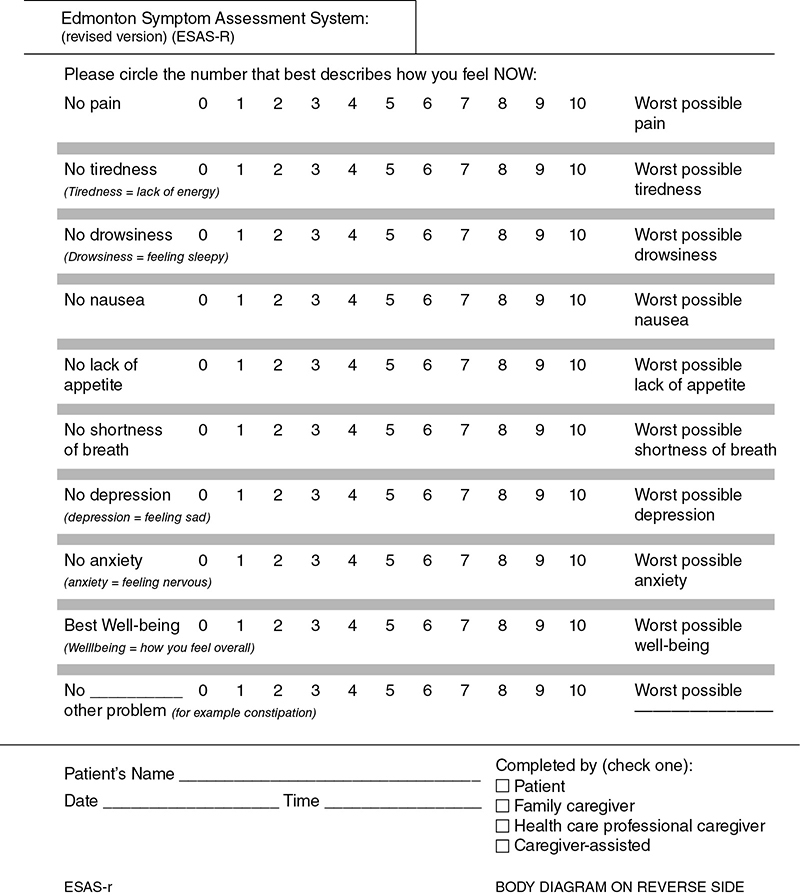
CACHEXIA AND ANOREXIA
FATIGUE
 Drugs and specific dosing regimens:
Drugs and specific dosing regimens:
DYSPNEA
 Thoracentesis
Thoracentesis
 If it reaccumulates, indwelling pleural catheter with intermittent drainage
If it reaccumulates, indwelling pleural catheter with intermittent drainage
 Pleurodesis
Pleurodesis
 Anticoagulation
Anticoagulation
 In select cases with massive pulmonary embolism and right heart strain, can consider thrombolysis
In select cases with massive pulmonary embolism and right heart strain, can consider thrombolysis
COUGH
SYMPTOM-DIRECTED TREATMENT
 Non-opioid
Non-opioid
 Opioid is first-line symptomatic treatment for severe, distressing cough.
Opioid is first-line symptomatic treatment for severe, distressing cough.
NAUSEA AND VOMITING
Stay updated, free articles. Join our Telegram channel

Full access? Get Clinical Tree


